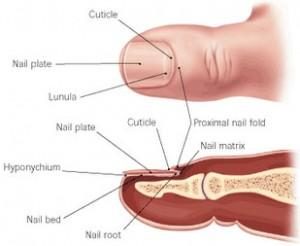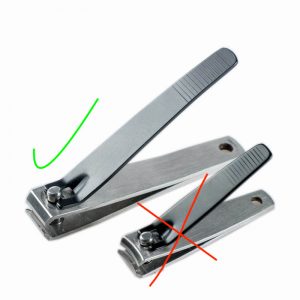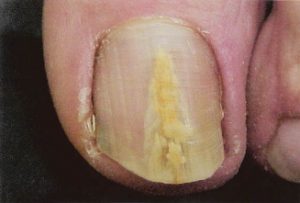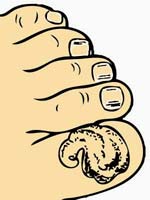Toenails, nature’s great protectors, are designed to protect the skin of our toes from injury, provide stability for the toes, and increase the sensitivity of the toe by producing counter-pressure against the pad of toes when encountering objects such as flooring, pebbles, etc..

Toenails, really, are quite amazing. Beyond being a nice place to put polish, toenails are marvels of engineering. The matrix, which is where new nail growth occurs, is strong yet sensitive. The matrix is easily damaged by continued pushing-back or removal of the cuticle, or by trauma such as being stepped on, or dropping something on it. A damaged nail matrix can become permanently damaged, continuing to produce an awkward or oddly-shaped nail for the rest of the person’s life.
Toenails grow approximately 1mm per month, much more slowly than fingernails.
What’s a hyponychium? Is it the same as a cuticle?
The hyponychium (hip-poh-nick-ee-um) is a very clever piece of engineering. It’s a very, very thin piece of tissue that grows just under the nail, providing protection from bacterial invasion into the nail bed. The hyponychium is also known informally as the ‘quick’. The cuticle, another super-thin membrane, protects the nail from the top, and also functions to keep bacteria and germs from invading the toenail.
Should I care about the hyponychium and cuticle?
Absolutely! Both of these tissues protect the nail and skin of the toes (and fingers too, actually), and are very important. Trimming off your cuticles for aesthetic reasons can be quite dangerous, as there’s now an opening for infection to plant itself. Sometimes an aesthetician will care for cuticles which includes softening with special oils, and gentle pushing back; this membrane shouldn’t be cut off or trimmed.
Trimming your toenails.
Be very careful trimming toenails. Use straight toenail clippers, not curved, working straight across in a ‘nibbling’ style from edge to edge.  Never trim all the white (free edge) of your toenails off – this cuts into the hyponychium and while creating a new open area for germs, can also be quite painful. Trim your toenails to a little longer than 1 mm, and then file carefully, smoothing out any rough edges. Remember, once a toenail’s been cut, it can’t be re-attached.
Never trim all the white (free edge) of your toenails off – this cuts into the hyponychium and while creating a new open area for germs, can also be quite painful. Trim your toenails to a little longer than 1 mm, and then file carefully, smoothing out any rough edges. Remember, once a toenail’s been cut, it can’t be re-attached.
Thick, yellowed, crumbling toenails?
If your toenails are thick and don’t fit inside the clipper blades, do not start looking in the garage or workshop for tools that might work. Workshop tools aren’t designed for use on living tissue. Using them can create a whole lot of problems that are easily avoided.

Having thick toenails might mean you have a fungal infection; check with your health provider to discuss diagnosis and treatment options. And if you’re wondering, polishing over fungus to hide it just wraps it in a nice little blanket, giving it a little holiday to grow and grow and grow…
Maybe your nails are just thick?
Sometimes as we age, nails can thicken and grow in unusual-looking shapes. This is easily managed by a foot care  professional, such as a foot care nurse or chiropodist. Again, please resist the urge to go looking for a workshop tool to help care for your nails. While it’s understandable that you might become desperate to take care of your toenails on your own, please do seek out professional, nursing or medical help for this.
professional, such as a foot care nurse or chiropodist. Again, please resist the urge to go looking for a workshop tool to help care for your nails. While it’s understandable that you might become desperate to take care of your toenails on your own, please do seek out professional, nursing or medical help for this.
Ingrowing toenails giving you a problem?
Don’t despair. Not every ingrowing nail is fully ingrown; sometimes just the corners of the toenails will be a little curled under, or can develop what might be called a ‘sled track’ underneath. This can often be cared for successfully and very conservatively by filing with a special file, from underneath. Cutting out the corners may help in the short-term, but you’ll find the problem quickly returns. If the nail is deeply ingrown, a visit to a chiropodist or podiatrist is your best option.
Missing a toenail?
Sometimes a toenail never re-grows after a trauma or after medical removal. A short-term solution of nail reconstruction might be just right for special events where sandals or strappy shoes are being worn.
Things that make you go hmmmm….
Be aware of any changes in the way your toenails look. Any dark areas, lines, unusual spots or shapes that you don’t know the origin of, need to be assessed by your doctor. It could be nothing, or it could be something – better safe than sorry.
Hence, therefore and most of all, please look after your toenails. They’ll thank you for it. If you need help or have any doubts, contact our St. Catharines foot clinic.


